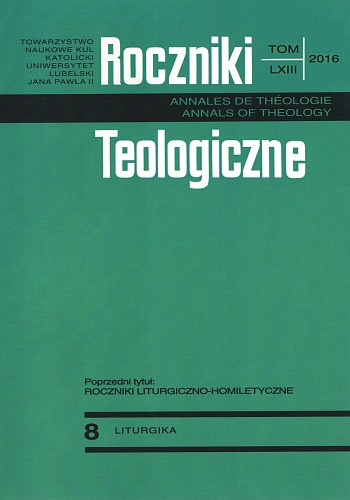The Celebration of the Mystery of the Incarnation of the Son of God in Light of Processions in Post-Tridentine Rituals of Wrocław of the 18th and 19th Centuries
The Celebration of the Mystery of the Incarnation of the Son of God in Light of Processions in Post-Tridentine Rituals of Wrocław of the 18th and 19th Centuries
Author(s): Waldemar PałęckiSubject(s): Christian Theology and Religion, History of Church(es), Theology and Religion, Pastoral Theology
Published by: Towarzystwo Naukowe KUL & Katolicki Uniwersytet Lubelski Jana Pawła II
Keywords: history of the liturgy; procession; Advent period; the Nativity; Feast of the Circumcision of the Lord; Epiphany; post-Tridentin liturgy; Piotrków Ritual; diocese of Wrocław
Summary/Abstract: Celebration of the mystery of the incarnation of the Son of God is mentioned for the first time in Chronograph (A.D. 354)—a fundamental document explaining the origin of this feast. Over the centuries the Incarnation of the Son of God was given emphasis in various ways through ceremonious celebration of this mystery. Among many liturgical customs are Sunday processions during Advent, at Christmas, and festivities held in this time and Sundays until 2 February. Sunday processions were known in the old Polish tradition and this custom was sanctioned in the Piotrków Ritual in 1631, but it does not feature processions for Advent Sundays, Christmas period, and holidays falling within this period. Liturgical texts intended for these days are present in four editions of the Wrocław Ritual of 1723, 1775, 1794 and 1847. The processions started with the singing of appropriate antiphons, which had their counterpart in the texts of Officium divinum of that period or a liturgical day. The antiphon Missus est Angelus Gabriel... for Advent Sundays was an exception. It was intended for the monastic liturgy of the 11th/12th centuries, and it can be found in antiphonary Saint-Maur-les-Fossés. During a procession, statio in the middle of a church was an important point for worship. A verse or a prayer was said concluded with the singing of an antiphon. The prayer was typically found in a missal form for a particular feast day except for Advent, when the prayer was read from a form for Marian masses. Notably, the well-known antiphon Pax aeterna... was sung only on Advent Sundays, which was replaced by the antiphon Hodie Christus natus est... during Christmas. Antiphons concluding processions, however, were taken from an officium, as it was done during Advent or Epiphany. The antiphon O beata infantia... is an exception, which is sung on the very Nativity Day, Circumcision Day, and on Sundays falling after Epiphany until the Fest of the Purification of the Virgin (2 February). This antiphon was present in the monastic tradition, for example in medieval antiphonaries of Saint-Denis and Saint-Maur-les-Fossés. Exploration of liturgical texts and various forms that are have been known over centuries as well as their origin makes it possible to sketch a full picture of traditions used in the Latin Church in the territory of Poland.
Journal: Roczniki Teologiczne
- Issue Year: 63/2016
- Issue No: 08
- Page Range: 121-140
- Page Count: 20
- Language: English

